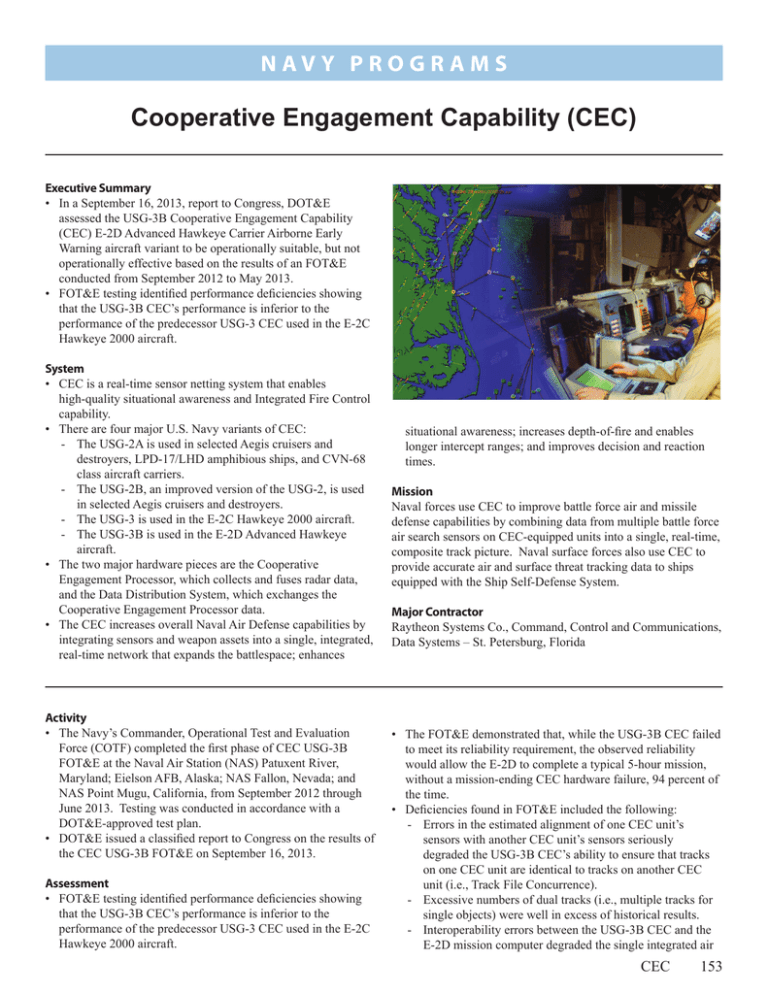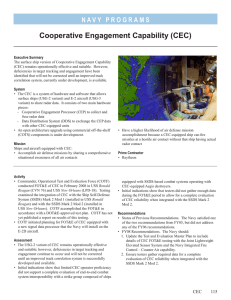Cooperative Engagement Capability (CEC)
advertisement

N av y P R O G R A M S Cooperative Engagement Capability (CEC) Executive Summary • In a September 16, 2013, report to Congress, DOT&E assessed the USG-3B Cooperative Engagement Capability (CEC) E-2D Advanced Hawkeye Carrier Airborne Early Warning aircraft variant to be operationally suitable, but not operationally effective based on the results of an FOT&E conducted from September 2012 to May 2013. • FOT&E testing identified performance deficiencies showing that the USG-3B CEC’s performance is inferior to the performance of the predecessor USG-3 CEC used in the E-2C Hawkeye 2000 aircraft. System • CEC is a real-time sensor netting system that enables high‑quality situational awareness and Integrated Fire Control capability. • There are four major U.S. Navy variants of CEC: - The USG-2A is used in selected Aegis cruisers and destroyers, LPD-17/LHD amphibious ships, and CVN-68 class aircraft carriers. - The USG-2B, an improved version of the USG-2, is used in selected Aegis cruisers and destroyers. - The USG-3 is used in the E-2C Hawkeye 2000 aircraft. - The USG-3B is used in the E-2D Advanced Hawkeye aircraft. • The two major hardware pieces are the Cooperative Engagement Processor, which collects and fuses radar data, and the Data Distribution System, which exchanges the Cooperative Engagement Processor data. • The CEC increases overall Naval Air Defense capabilities by integrating sensors and weapon assets into a single, integrated, real-time network that expands the battlespace; enhances Activity • The Navy’s Commander, Operational Test and Evaluation Force (COTF) completed the first phase of CEC USG-3B FOT&E at the Naval Air Station (NAS) Patuxent River, Maryland; Eielson AFB, Alaska; NAS Fallon, Nevada; and NAS Point Mugu, California, from September 2012 through June 2013. Testing was conducted in accordance with a DOT&E-approved test plan. • DOT&E issued a classified report to Congress on the results of the CEC USG-3B FOT&E on September 16, 2013. Assessment • FOT&E testing identified performance deficiencies showing that the USG-3B CEC’s performance is inferior to the performance of the predecessor USG-3 CEC used in the E-2C Hawkeye 2000 aircraft. situational awareness; increases depth-of-fire and enables longer intercept ranges; and improves decision and reaction times. Mission Naval forces use CEC to improve battle force air and missile defense capabilities by combining data from multiple battle force air search sensors on CEC-equipped units into a single, real-time, composite track picture. Naval surface forces also use CEC to provide accurate air and surface threat tracking data to ships equipped with the Ship Self-Defense System. Major Contractor Raytheon Systems Co., Command, Control and Communications, Data Systems – St. Petersburg, Florida • The FOT&E demonstrated that, while the USG-3B CEC failed to meet its reliability requirement, the observed reliability would allow the E-2D to complete a typical 5-hour mission, without a mission-ending CEC hardware failure, 94 percent of the time. • Deficiencies found in FOT&E included the following: - Errors in the estimated alignment of one CEC unit’s sensors with another CEC unit’s sensors seriously degraded the USG-3B CEC’s ability to ensure that tracks on one CEC unit are identical to tracks on another CEC unit (i.e., Track File Concurrence). - Excessive numbers of dual tracks (i.e., multiple tracks for single objects) were well in excess of historical results. - Interoperability errors between the USG-3B CEC and the E-2D mission computer degraded the single integrated air CEC 153 N av y P R O G R A M S picture presented to the various combat systems (e.g., other E-2Ds, Ship Self-Defense System Mk 2 Combat Systems, and Aegis Combat System) in the CEC network and datalink networks with the E-2Ds. - Electromagnetic interference between the USG-3B CEC and the E-2D radar altimeter caused the altimeter readings to be unreliable at certain altitudes. • The classified September 16, 2013, DOT&E report to Congress contains further USG-3B CEC related details and recommendations. • DOT&E approved the CEC Test and Evaluation Master Plan (TEMP) in May 2012. The TEMP requires an update to address all future phases of CEC operational testing. Recommendations • Status of Previous Recommendations. The Navy has satisfied all of the previous recommendations. • FY13 Recommendations. The Navy should: 1. Determine the root cause of the problem that degrades the USG-3B CEC’s Track File Concurrence and demonstrate corrections in a phase of FOT&E. 2. Implement changes to the USG-3B CEC interface with the E-2D mission computer that would allow data from the E-2D’s APY-9 radar to be used by the USG-3B CEC without first requiring the creation of an E-2D Mission Computer track. 154 CEC 3. Reassess the USG-3B CEC reliability requirement and whether the logistic supply system can support the demonstrated USG-3B CEC reliability. 4. Correct the cause of the electromagnetic interference between the USG-3B CEC and the E-2D radar altimeter and demonstrate the corrections in a phase of FOT&E. 5. Take action on the recommendations contained in the classified DOT&E report to Congress on the CEC USG-3B FOT&E. 6. Update the CEC TEMP to include details of: -- The second phase of the USG-3B FOT&E with the supersonic seaskimming target scenario -- FOT&E of corrections made to the CEC USG-3B -- FOT&E of the CEC USG-2B with the Aegis Baseline 9 Combat System -- FOT&E of the CEC USG-2B with the DDG 1000 Combat System -- FOT&E of the CEC USG-2B with the CVN-78 Combat System -- FOT&E of USG-3B CEC to demonstrate the system’s ability to support the E-2D’s Theater Air and Missile Defense and Battle Force Command and Control missions -- The test program supporting the Acceleration of Mid- term Interoperability Improvements Project





